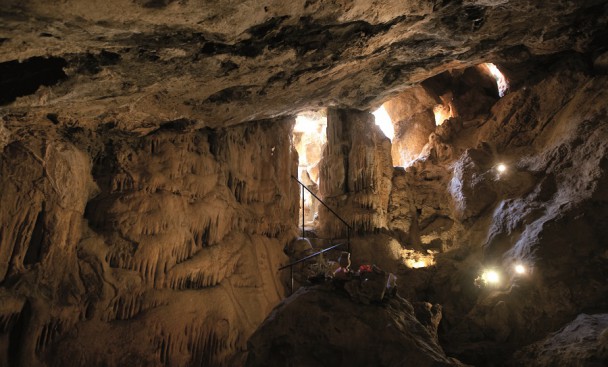This one hundred-and-fifty-meter-high cave is located within Can Quintals property, a few kilometers away from Sant Vicent cove. Archeologically speaking, Es Culleram was discovered in 1907. That same year the Ebutisan Archeological Society organized an excavation campaign that led to the discovery of a large number of terracotta figures (approximately 600 whole, and more than a thousand heads), and other materials, such as a bone or ivory lion. But one of the most important objects is a plaque with a double Punic inscription. It was found by chance in 1917, and today it can be seen in the Provincial Archeological Museum of Alicante.
In the oldest side, it says: “To the master, to Resef-Melkart, this sanctuary that ‘s’dr has dedicated, son of Ya’as ay, son of brgd , son of Eshmunhilles.” The modern one reads: “Abdeshmun, son of Azarbaal, the priest, has made, dedicated, and repaired this wall by himself for our Lady, for Tanit the almighty, and for Gad.
Discontinuously, until 1981, this crucial site was the object of many archeological interventions of diverse categories; unfortunately some of them were clandestine. Today, it belongs to the Ibiza ‘s Insular Council. All the demolished stone block system from the first natural room, whose collapse threatened to bring down the whole monument, was consolidated by the owner institution.
A part from the prehistoric period (when the cave was probably the home of a group of inhabitants from the Bronze Age, which seems not to have continued until the Phoenician-Punic period), from the 5th century forward, it became a sanctuary. At first it was dedicated to Reseph-Melkart; later, during the 3rd or 2nd centuries, to Tanit.
There are a series of artificial modifications in the monument which belong to the later period, such as the preservation of part of an artificial room with the deeper part of it carved in the stone, and to its side, the end of a typical Punic tank.
The sanctuary was located within a great natural hole that water streaming had divided into several rooms, specially two big ones, separated by a large curtain of stalactites. Besides this, we can still contemplate the aforementioned artificial structures in the entrance area.
If we have to evaluate the recently revised data from the first diggers, we will have to think that the deep rooms were some kind of botrhos (sacred deposit) where the remains of the sacrificial offerings were accumulated. They were represented by divine figures, which in most cases corresponded to Tanit’s bust covered in a winged shawl. Furthermore, there were remains of many animals used during the sacrifices, and obviously, many more. These rites that required the use of fire, by logic, had to take place in the outer part or vestibule of the sanctuary.
At the same time as these verified cults were taking place in Es Culleram temple, all the Sa Cala canal was well-inhabited, and there was no doubt that these people were the most directly implicated in the cult. Despite this, at the same time, it was probably an international sanctuary, well-connected by sea through Sa Cala port. At least, as an organized temple it was almost totally abandoned in the 2nd century. The natural collapse of the first big room from the cave may have been the reason for the end of the cult within the Punic Sanctuary of Es Culleram.
Address: Sant Vicent de sa Cala
